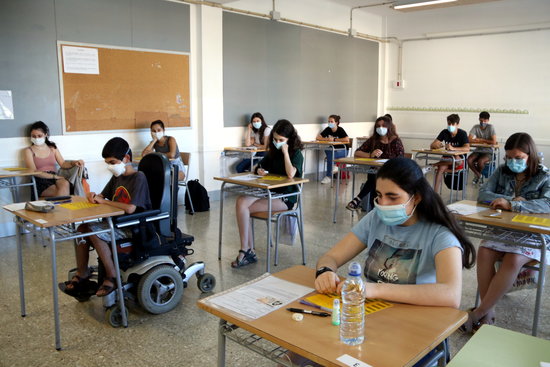Temperature readings and mass screenings to be performed at schools
Education and health departments present plan that also includes staggered arrival times for pupils

Schools will open on September 14, the day the academic year starts, and all students will be able to attend.
This is what authorities continue to make clear despite the ongoing growth in the number of Covid-19 cases.
On Tuesday, an extraordinary session of the Catalan cabinet passed a special plan for a return to the classroom, which includes pupils' temperatures being taken upon their arrival.
The health department will use mobile units to perform some 8,000 PCR tests every day from September 15 to October 9, and up to 20,000 daily from mid-October to November 15 – the Catalan president, Quim Torra, said on Monday that some 500,000 such tests will be performed at schools between September 15 and November 15.
The plan also includes staggered arrival times for pupils and class sizes limited to no more than 20 students in primary. For secondary schools, the number of students also has to be lower than usual, although the maximum amount has not been specified.
Both the education minister, Josep Bargalló, and the health minister, Alba Vergés, said that "stable groups" will be important in order to track and trace potential Covid-19 cases.
Lessons will last approximately 55 minutes, five less than usually, in order to ventilate the classroom.
Face masks
The face masks will be compulsory for those over 12 everywhere at school, and those younger (but over 6) will also be obliged to wear them when the area where the center is located is labeled as 'red', meaning high epidemiological situation. Depending on the activity or the area within the school, pupils between 6 and 12 can also be told to use masks.
As for teachers, they will have to wear them when in contact with several groups at the same time, and it will be recommended with "stable groups."
Six-month hiatus on full classroom teaching
Schools and universities across Catalonia shut their gates in March as the coronavirus pandemic began to take hold. Some 1.56 million students were affected by the measure, with over 200,000 more in higher education centers.
As lockdown measures began to ease, schools tentatively reopened again for certain activities from the beginning of June, such as individual tutoring sessions, by appointment, for students at a greater disadvantage, and group sessions for students transitioning into a different educational stage.
Health and safety measures for the new school year were published on July 3 in a document entitled 'Action Plan for the 2020-2021 academic year for schools in the framework of the pandemic'.
The main initiatives outlined in that plan were staggered ten-minute time slots for the beginning and end of the school day, staggered break times, and fixed student groups.